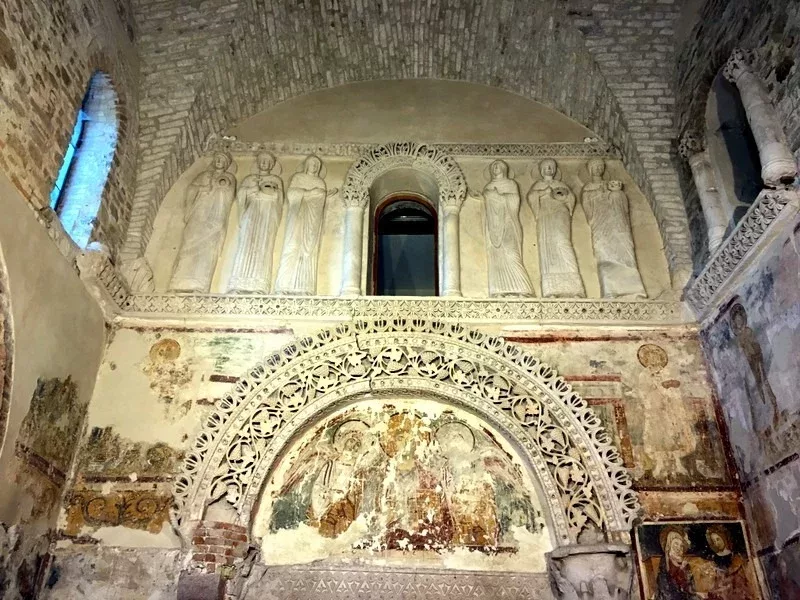Could we define Longobard art as a Germanic art? Yes we could but not only! Yes because Longobards have been a germanic population which invaded and dominated at first Northern Italy and then spread in almost all italic territory and that brought with it its peculiar art form of Germanic imprint. As often happens even Germanic art in question,was influnced by byzantine one,so much that there was a gradual process of merging which led to the development of a Romano-germanic art!
The main artistic field in which they operated was goldsmithing that blended Germanic tradition along with late-Roman one. In different Longobards necropolis were found jewerly,ornaments and weapons but also fibulae,cross-stitches in gold foil which were used as amulets instead of bracteates of Germanic derivation.Among masterpieces of goldsmithing there is the Cross of Agilulf composed of hard stones of different sizes cold-embedded; worth mentioning even The Hen with Chicks and The Iron Crown as well as Evangelary of Theodolinda worked with gold plates and decorated with gems and precious stones. Like i said longobards used to decorated their weapons and they did it in a serious way evidenced by finding of Schield of Stabio in which we can notice dynamic and elegant animal figures processed in bronze and applied on a wooden shield covered in leather.
In architecture and building Longobards weren’t great innovators in fact they were limited to rebuild and restore pre-existing buildings of Late antiquity.Most Longobard architectural activity was based on the construction of churches, monasteries and baptisteries. One of the few baptisteries that has survived to the present day is that of St. John ad Fontes while so many other churches and monasteries have been lost or extensively reworked that very often only the crypts remain as the only reference of the original construction. In the ancient Longobard capital, that is Pavia, there are various lost traces of ancient Longobard churches while the only existing Longobard building in Monza is the so-called Longobard Tower. The most famous and intact monument of all Longobard architecture remains the Longobard Tempietto which is located in Cividale del Friuli and dates from the mid-13th century. A distinctive decorative tradition flourished in the Longobard monasteries that reached its fullest expression in the miniatures that embellished the codices compiled by monks in the second half of the 8th century so much so that this period was referred to as the “Longobard School.”

Like all Germanic peoples the Longobards did not sculpt in the round so there are no examples of monumental sculpture from the Longobard era in fact their form of sculpture was limited to architectural and liturgical decoration. The decorative forms adopted in this sphere were usually highly stylized animal forms and geometric patterns. During the time of the Longobard king Liutprand there was an artistic renaissance lasting about a decade that led to the rediscovery of classical models. Masterpieces from this period include the baptismal font of Patriarch Callistus and the altar of Duke Rachis. Also worth mentioning are the Theodotus plutei depicting two peacocks drinking at a font surmounted by a Cross and the fragment of a pluteus with a lamb’s head. In most of the sculptural slabs found, one notices mainly religious themes of a Christian stamp represented in a highly stylized and symbolic manner through animal figures and geometric motifs, as is evident in the slab with a peacock from St. Savior and the tomb slab from St. Cumianus.
In the field of painting there is an objective difficulty in recognizing the Longobard imprint in Northern Italy due to several factors including the continuous succession of various peoples and cultures such as the Latins, the Greek-Byzantines and the Germanic but also due to the few pictorial testimonies relating to the only two centuries of Longobard rule. It is a different matter as far as southern Italy is concerned where one can recognize and analyze the Benevento figurative culture that developed thanks to the permanence of numerous duchies and principalities including the principality of Benevento. The famous Longobard Tempietto contains a cycle of frescoes preserved not too well as also damaged are the frescoes in the monastery of Torba. The monastery of San Vincenzo al volturno founded by Longobard nobles in 703 contains a cycle of frescoes telling the stories of biblical prophets although the best known frescoes in this monastery date from the time of Abbot Epiphanius.These frescoes are distinguished by bright, vivid colors and a rather loose and confident drawing as well as great drama and a lack of architectural framing, and in fact for their style they come close to the Benevento school of miniature painting. Between the 8th and 9th centuries, other pictorial evidence scattered throughout Campania, Molise and Apulia should be mentioned, particularly in the Grotto of St. Biagio, the Grotto of St. Michael, the churches of Santa Maria de lama in the small temple of Seppannibale and the Sanctuary of St. Michael the Archangel.
Conclusions
Longobard art, like most medieval art, was permeated with a strong religious imprint that in architecture was expressed in the construction of churches, monasteries, and baptisteries and thus followed the trace left by late Roman and Byzantine culture . In these sacred buildings other artistic forms developed as happened to other peoples such as wall painting and architectural and liturgical decorative sculpture that was mainly characterized by low-relief carved works. Longobard painting was distinguished above all by the frescoes of the Benevento school and by the valuable miniatures contained in the manuscripts compiled by the monks, but it was in goldsmithing that Longobard art expressed itself at the highest level, creating true masterpieces no less important than those of other barbarian peoples who were great masters in the working of precious stones.
